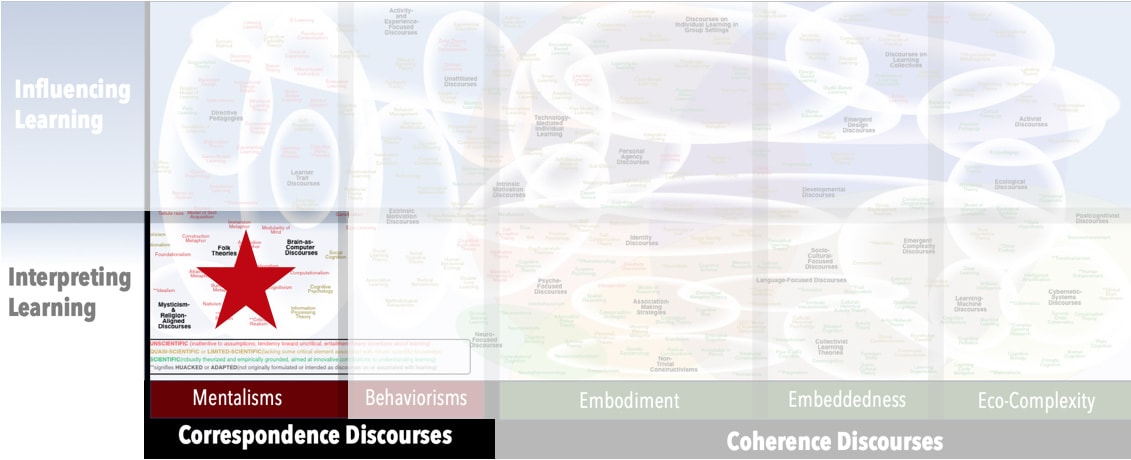Focus
Personal learning, in terms of “getting it”Principal Metaphors
- Knowledge is … object, commodity, material
- Knowing is … having/retaining of knowledge
- Learner is … a recipient (individual)
- Learning is … acquisition, getting, buying
- Teaching is … relaying, conveying, delivering
Originated
Ancient (entrenched in the language)Synopsis
“Learning as acquisition” – the Acquisition Metaphor – is probably the most commonly invoked learning metaphor in English. It is evident in such phrases as “grasping the point,” “taking things in,” “getting it,” “picking things up,” “hard to swallow,” “remember this stuff,” and “cramming for the test.” It is not theoretically sophisticated, relying on the assumption that knowledge comprises externalized objects, and asserting that learning is a process of moving those objects from the outside to the inside. Closely associated and complementary metaphors include:- Accretion – literally referring to increases through gradual accumulation of layers, a term that is used in multiple formal theories of learning (especially Behaviorisms, as a metaphor to describe the cumulative effect of repeated experiences, and Cognitivism, where it's interpreted in terms of encoding new information in relation to already encoded information). Often used interchangeably with “acquisition.”
- Conduit Metaphor (Michael Reddy, 1970s) – a model in which human communication is understood as a three-step process through which (1) the sender puts thought-objects into word-containers and then (2) shunts those words to a receiver (through some manner of conduit), who (3) extracts the meaning from the word-containers.
- Cumulative Learning – a popular term most often used to refer to the gradual accretion of knowledge and skills over time. That is, the notion is typically interpreted in terms of the Acquisition Metaphor, although it can be (and is) used across many theories and interpretations of learning.
- Grasping Metaphor (ancient) – a metaphor for learning, understanding, and knowing that is common across most European languages – especially the Romance languages (e.g., French, Italian, Spanish), among which it serves as principal metaphor for learning (see Metaphors of Learning in Different Languages). In English, the Grasping Metaphor is perhaps most noticeable among such familiar expressions as “getting it,” “holding onto an idea,” “catching on,” and “losing grip,” but it is more subtly present in words such as “comprehend” (from the Latin prehendere “to catch hold of, seize”).
Commentary
Stated nakedly, no-thing moves from outside the knower to the inside in moments of learning – or, phrased differently, there is no empirical evidence whatsoever to support this or related Folk Theories. Nevertheless, the Acquisition Metaphor is so intricately woven into everyday English that it’s nearly impossible to notice when it is being invoked or its purely figurative nature. Got that? It’s a cold hard fact and it can be hard to swallow. While such phrasing seems benign, they infuse and are sued to legitimate many dubious educational beliefs and practices. (There are too many to mention, but one powerful illustrative example is the notion of “intelligence as capacity” – that is, how much can be held – which arises from an unquestioned assumption that knowledge is something that can be held. There is a very small step from this notion to practices of measuring and ranking these fictional capacities.) Many critiques have arisen around the Acquisition Metaphor, including ones focused on the following popular-but-problematic associations:- Acquisitive Learning – a phrase that is most often associated with Behaviorisms (i.e., based on the model of manipulating the environment to manage behavior change), but that is occasionally used interchangeably with the Acquisition Metaphor.
- Banking Model (of Education) (Paulo Freire, 1970s) – a term used to critique any approach to formal education that uncritically embraces the Acquisition Metaphor.
- Transmission Model (of Education) – a deprecating phrase applied to teaching approaches that are uncritically based the Acquisition Metaphor and Conduit Metaphor – i.e., in which education is seen as the transmission of knowledge from teacher to student.
- Truth Metaphor – from the PIE root *deru- “be firm, solid”
Authors and/or Prominent Influences
No one knows when this notion was first embraced. The fact that it’s prominent across most western languages has been used as evidence that it might be linked to the emergence of alphabet-based literacies, which provided means to “objectify” personal knowings by allowing knowers to preserve thoughts and communicate them across distances and time.Status as a Theory of Learning
The Acquisition Metaphor falls among Folk Theories.Status as a Theory of Teaching
While not a theory of teaching, interpreting knowledge as objects and learning as acquisition has immediate and “commonsensical” prescriptions for teaching. In this frame the teacher would be expected to deliver (relay, convey, transmit, present, etc.) knowledge-objects, which would prompt emphases on pre-stated objectives, clear explanations, direct instruction, standardized evaluations, and so on.Status as a Scientific Theory
The Acquisition Metaphor meets none of the requirements of a scientific theory.Subdiscourses:
- Accretion
- Acquisitive Learning
- Banking Model (of Education)
- Conduit Metaphor (Conduit Model of Communication)
- Cumulative Learning
- Grasping Metaphor
- Transmission Model (of Education)
- Truth Metaphor
Map Location

Please cite this article as:
Davis, B., & Francis, K. (2024). “Acquisition Metaphor” in Discourses on Learning in Education. https://learningdiscourses.com.
⇦ Back to Map
⇦ Back to List
